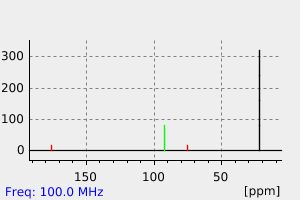5,5-dimethyl-1,3-dioxolan-4-one | 2049-10-7
中文名称
——
中文别名
——
英文名称
5,5-dimethyl-1,3-dioxolan-4-one
英文别名
5,5-dimethyl-[1,3]dioxolan-4-one;5,5-Dimethyl-[1,3]dioxolan-4-on;5,5-Dimethyl-1,3-dioxolon-(4);Dimethyl-5,5-dioxolanon-4
CAS
2049-10-7
化学式
C5H8O3
mdl
——
分子量
116.117
InChiKey
XIVQEWDTUYGVEU-UHFFFAOYSA-N
BEILSTEIN
——
EINECS
——
-
物化性质
-
计算性质
-
ADMET
-
安全信息
-
SDS
-
制备方法与用途
-
上下游信息
-
文献信息
-
表征谱图
-
同类化合物
-
相关功能分类
-
相关结构分类
物化性质
-
沸点:146-148 °C
-
密度:1.098±0.06 g/cm3(Predicted)
计算性质
-
辛醇/水分配系数(LogP):0.5
-
重原子数:8
-
可旋转键数:0
-
环数:1.0
-
sp3杂化的碳原子比例:0.8
-
拓扑面积:35.5
-
氢给体数:0
-
氢受体数:3
反应信息
-
作为反应物:描述:5,5-dimethyl-1,3-dioxolan-4-one 在 正丁基锂 、 硫酸 、 sodium hydride 、 二异丁基氢化铝 作用下, 以 四氢呋喃 、 二氯甲烷 为溶剂, 反应 7.5h, 生成 4-methyl-1-phenyl-4-[(phenylseleno)methoxy]-1-pentyn-3-ol参考文献:名称:通过依次进行5-外-对-基自由基环化,从硅中转移1,5-氢和5-内-三角环化来制备多环系统。摘要:类型1的基团经历5-exo对角环化,并且所得的乙烯基自由基从硅中提取氢以提供以硅为中心的自由基。该自由基以5-内三角键关闭,生成4型自由基,该自由基被锡烷还原(4-> 5),除非起始乙炔带有末端三甲基锡烷基。在这种情况下,自由基4排出三甲基锡烷基以提供乙烯基硅烷6。自由基级联1→5的立体化学结果受1中含氧碳的立体化学控制(请参阅加星标的原子)。该序列可以由碳,α-取代的碳,氧酰基和氨基甲酰基基团起始,并产生稠合到碳环或杂环上的含硅环。描述了许多示例,DOI:10.1021/jo001124x
-
作为产物:描述:参考文献:名称:Reaction of α-Peroxy Lactones with C, N, P, and S Nucleophiles: Adduct Formation and Nucleophile Oxidation by Nucleophilic Attack at and Biphilic Insertion into the Peroxide Bond摘要:The reactions of the alpha-peroxy lactones 1 with a variety of carbon, nitrogen, phosphorus, and sulfur nucleophiles yield, on S(N)2 attack at the more electrophilic alkoxy oxygen of the peroxide bond, diverse addition and oxygen transfer products, together with the catalytic Grob-type fragmentation. The nature of the nucleophile determines the fate of the open-chain intermediate I. Thus, protic nucleophiles such as primary and secondary amines and thiols lead to the second intermediate I' through proton shift subsequent to the S(N)2 step, while nonprotic amines and sulfides, as well as diazoalkanes, lead to oxidation products or to the cycloadducts 10-15. Trivalent phosphorus nucleophiles such as phosphines and phosphites and diisopropyl sulfoxylate prefer biphilic insertion, as documented by the fact that the nucleophilicity rather than the steric demand of these reagents controls their reactivity. The labile adducts undergo a variety of transformations to the final stable products. For protic nucleophiles, the amine adducts 5 and 6 are sufficiently persistent for isolation, whereas the sulfenic esters formed by thiol addition are further oxidized to the sulfinic esters 7 and 8 or react with excess thiol to the corresponding disulfides. For aprotic nucleophiles, the dipolar intermediates I decompose into acetone and CO2 with regeneration of the nucleophile (Grob-type fragmentation), as seen for DABCO and pyridine N-oxide, or they extrude the alpha-lactone to afford the oxygen transfer product. The corresponding ketones, pyridine N-oxide, sulfoxides, and sulfones are obtained by this route from diazoalkanes, pyridine, sulfides and sulfoxides. Additionally, the diazoalkane intermediates I also cyclize to the cycloadducts 10-12. The thermally labile phosphorus adducts 13-15, which were observed by low-temperature NMR spectroscopy, decompose to the alpha-lactone and the phosphorus oxides. Analogously, diisopropyl sulfite is obtained from the sulfoxylate adduct. As for the fate of the alpha-lactones (the reduction products of the alpha-peroxy lactones), the dimethyl derivative either oligomerizes to the oligoester 2a or is trapped by methanol as the alpha-methoxy acid 4a, while the spiroadamantyl alpha-lactone decarbonylates to adamantanone.DOI:10.1021/jo962039l
文献信息
-
Lobry de Bruyn; van Ekenstein, Recueil des Travaux Chimiques des Pays-Bas, 1902, vol. 21, p. 316作者:Lobry de Bruyn、van EkensteinDOI:——日期:——
-
Preparation of tetrahydrofuran, γ-lactone, chromanol and pyrrolidine systems by sequential 5-exo-digonal radical cyclization, 1,5-hydrogen transfer from silicon, and 5-endo-trigonal cyclization作者:Derrick L. J. Clive、Wen YangDOI:10.1039/cc9960001605日期:——Sequential 5-exo-digonal radical closure, intramolecular 1,5-hydrogen transfer from silicon to carbon, and 5-endo-trigonal closure of the resulting silicon-centred radicals are used to make five- and six-membered heterocycles containing oxygen or nitrogen.
-
Palomaa; Salmi; Wallin, Chemische Berichte, 1935, vol. 68, p. 617作者:Palomaa、Salmi、WallinDOI:——日期:——
-
Derivative of cellulose solvent and method of employing the same申请人:CELANESE CORP公开号:US01962157A1公开(公告)日:1934-06-12
表征谱图
-
氢谱1HNMR
-
质谱MS
-
碳谱13CNMR
-
红外IR
-
拉曼Raman
-
峰位数据
-
峰位匹配
-
表征信息
同类化合物
顺式-2-甲基-4-叔-丁基-1,3-二氧戊环
过氧竹红菌素
辛醛丙二醇缩醛
碘丙甘油
甜瓜醛丙二醇缩醛
甘油缩甲醛
甘油缩甲醛
环辛基甲醛乙烯缩醛
环戊二烯内过氧化物
环己丙胺,1-(1,3-二噁戊环-2-基)-
环丙羧酸,2-乙酰基-,甲基酯,(1R-顺)-(9CI)
氯乙醛缩乙二醇
柠檬醛乙二醇缩醛
异戊醛丙二醇缩醛
异丁醛-丙二醇缩醛
奥普碘铵
多米奥醇
多效缩醛
壬醛丙二醇缩醛
四吖戊啶,5-(1-吡咯烷基)-
亲和素
二氰苯乙烯酮乙烯缩醛
乙酮,1-(2-环辛烯-1-基)-,(-)-(9CI)
乙基1,3-二氧戊环-4-羧酸酯
丙炔醛乙二醇缩醛
三甲基-[(2-甲基-1,3-二氧戊环-4-基)甲基]铵碘化物
三氟乙烯臭氧化物
三丁基(1,3-二恶烷-2-基甲基)溴化鏻
[2-(2-碘乙基)-1,3-二氧戊环-4-基]甲醇
6,8-二氧杂二螺[2.1.4.2]十一烷
6,7-二氧杂双环[3.2.1]辛-2-烯-8-羧酸
5H,8H-呋喃并[3,4:1,5]环戊二烯并[1,2-d]-1,3-二噁唑(9CI)
5-过氧化氢基-5-甲基-1,2-二恶烷-3-酮
5-嘧啶羧酸,4-(2-呋喃基)-1,2,3,4-四氢-6-甲基-2-羰基-,1-甲基乙基酯
5-(哌嗪-1-基)苯并呋喃-2-甲酰胺
5-(1,3-二氧杂烷-2-基)呋喃-2-磺酰氯
5-(1,3-二氧戊环-2-基)戊腈
5,5-二羟基戊醛
4a-乙基-2,4a,5,6,7,7a-六氢-4-(3-羟基苯基)-1-甲基-1H-1-吡喃并英并啶
4-硝基-4-丙基辛醛乙烯缩醛
4-甲基-4-硝基辛醛乙烯缩醛
4-甲基-2-戊基-1,3-二氧戊环
4-甲基-2-十一烷基-1,3-二氧戊环
4-甲基-2-[(1E)-1-戊烯-1-基]-1,3-二氧戊环
4-甲基-2-(三氯甲基)-1,3-二氧戊环
4-甲基-2-(2-(甲硫基)乙基)-1,3-二氧戊环
4-甲基-2-(1-丙烯基)-1,3-二氧戊环
4-甲基-1,3-二氧戊环
4-烯丙基-4-甲基-2-乙烯基-1,3-二氧戊环
4-溴-3,5,5-三甲基二氧戊环-3-醇







